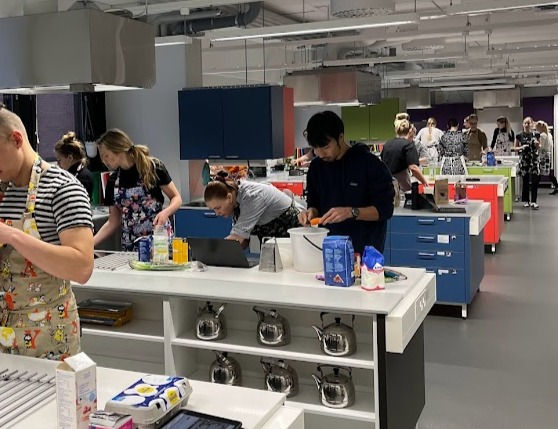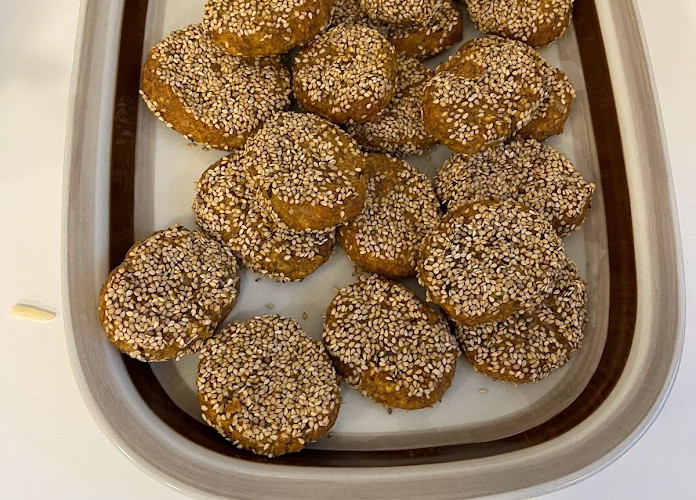Home Economics - University Culinary Observations
- Dawn Oler

- Feb 6, 2024
- 5 min read
Please remember that I am going to put some observations here through the lens of a U.S. teacher. I will try to formulate my thoughts in a way that is inquisitive and appreciative of the societal differences and expectations. Throughout this post you will see images and videos that were recorded of the staff and students at the school. These have been shared with permission.

Last week I was lucky to be invited to observe a culinary lab in the Home Economics program at the University of Eastern Finland. The course was Sustainable Development in Food and Nutrition Systems. This is a master’s level course for Home Economics Students and International Masters Program students in their last semester. The goals of the course are as follows;
Students will be able to:
• discuss sustainable development indicators related to the food and nutrition system and identify related research methods
• critically consider the current practices of households and consumers from the perspective of sustainable food management and nutrition
• reflect on the students own actions from the perspective of different dimensions of sustainability and argue their own choices
• apply what the student has learned and is able to combine and evaluate broader contexts in the sustainability of household activities.
The course is expected to require 135 hours of time over the semester. According to the syllabus Dr. Hille Janhonen-Abruquah shared, this includes 10 hours of large group instruction, 10 hours of practical/lab sessions and 135 hours of independent work as students complete their research products. Evaluation is based on "active participation in teaching, online assignments, writing a scientific essay and planning and conducting a
pedagogical session/lesson. Essay 0-5 (70%) and pedagogical session 0-5 (30%), online assignments (Accepted-Rejected)." The class I observed had 18 students, with 3 male presenting. I note this because as in the U.S. the profession is largely occupied by females. Home Economics in Finland does not include quantity food production or hospitality, that is another department. So these students do study safety and sanitation, however, they do not have the same strict standards as a food service establishment would. In the U.S. many Family and Consumer Sciences Programs follow restaurant industry food service and sanitation practices.
The lesson prior to this lab was studying the environmental pyramid. During this unit, students are researching nuts and pulses (beans, lentils, peas). Students find a recipe for one of the ingredients they haven’t tried before, they are supposed to test the recipe at home and submit it with a grocery order by the due date. Everyone in class goes to do grocery shopping at some point in the semester. Hille assigns the shopping to small groups prior to each of the labs. She did have to get a few things the students couldn’t find. The department credit card is given to the group to use when purchasing ingredients. Once students submit their grocery order to a shared spreadsheet the students in charge of shopping sort, combine and organize list. They check stock at school then go together to shop and bring the ingredients back to school. The professor does not need to be at the school. Students can access the space with a key fob. This process is excellent preparation for teaching Home Economics as it is precisely how many teachers in the U.S. carry out these responsibilities as well.
Cabinet Staples Storage
The course starts at 8:15. Hille was here ahead of time to set up materials. All students have their recipes up on their computers. The class starts by discussing the lesson, this is teacher led with student responses. I notice there are only a couple cell phones out and they could be using those for their recipes. In a class of 18 I only saw two out during instruction and I really didn't see any again until they were taking pictures of their products. #CameraEatsFirst Students are pre-divided into groups of three. Once in their groups, students decide who is making which recipe, they will prepare the recipe someone else has written and adapted. Student's read each other's recipes and ask questions and clarify directions, before heading into the kitchen labs.
Sweet Buffet
Students are in socks and indoor shoes while in the kitchens. They bring their own aprons and have their hair up if it is long. I believe all students have been in cooking courses before. They appear organized and know basic sanitation and safety procedures. Anniina, who was kind enough to chat with me while preparing her recipe, said she had participated in another course that taught kitchen safety and sanitation. Anniina is preparing Chocolate Lupine Bars. I had never heard of these before, I don't think we use them in the U.S.. The Lupine bean is dried and hulled and the seed is ground up. For those who love trying new ingredients and recipes, if you use Google translate, this website has recipes https://www.koivunalho.fi/.
Savory Buffet
Throughout the lab, students are entirely engaged in the process. They are asking each other questions and for guidance. They are adjusting, one group tried their soup (I watched them use a spoon, one task, spoon to sink) and did not like the texture of the seed coating in it. So they strained it through a sieve and then used the immersion blender to further smooth it out. They also adjusted for taste slightly with the addition of salt. They made notes on the slide following the recipe of these adjustments. There was a natural flow of teamwork and dovetailing tasks within the groups.
Students set up the food buffet style and with labels. Line to get food then sit and discuss flavor, recipe rewrite and recipe preparation feedback. During the meal, students shared what went well with the recipe as written and what did not work out or what they would change. After the meal, students take extras home in leftover containers from food preparation. Cleanup is easily completed amongst students themselves without teacher direction they understand what needs to be completed and all contribute. Which is great, because they will be facilitating that for much of their careers!
In my opinion this lab demonstrated excellent preparation skills for teaching foods/culinary courses. From ordering ingredients, to rewriting recipes to shopping and organizing groups. This exercise allowed students to become familiar with a variety of foods they may not have had before, research a recipe within constraints, test and rewrite a recipe, prepare a grocery order, shop and provide feedback on others products. All in all a comprehensive overview of what teaching culinary arts entails.
The author of this website/blog/etc. is a participant of the Fulbright Distinguished Awards in Teaching Research Program (Fulbright DA), a program sponsored by the U.S. Department of State’s Bureau of Educational and Cultural Affairs (ECA) with funding provided by the U.S. Government and administered by IREX. The views and information presented are the participant's own and do not represent the U.S.

































Comments